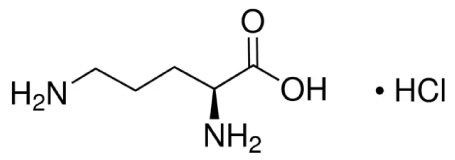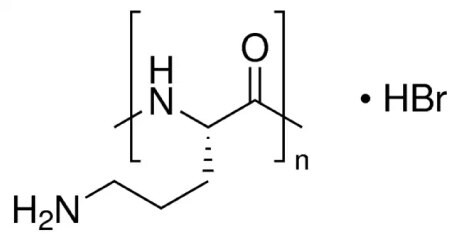L-Ornithine in Cell Culture
What is L-Ornithine?
L-ornithine is an amino acid that is not encoded in the genome of organisms. However, it is still used in cells for protein assembly. The literally meaning of the word ornithine is “pertaining to birds”. It was first identified by the chemist Jaffe in 1877 from ornithuric acid, a compound that is isolated from the urine of birds.

Figure 1.Structure of L-ornithine.
This amino acid has been widely used in pharmaceutical and food industries due to its beneficial effects on the liver and the heart1 , 2, 3. L-ornithine products often contain the molecule hydrochloride, which is used to balance the pH of the product. Although this amino acid is not encoded in the genome and it is not an amino acid component of proteins, it plays critical roles in multiple metabolic and synthesis pathways in organisms.
Related Products
What does Ornithine do?
Ornithine is one of the most critical non-protein amino acids besides the 22 proteinogenic amino acids. It is involved in the synthesis of many products, many of which are tremendously important for living cells. It is a key precursor in the biosynthesis of multiple amino acids including proline, glutamic acid, and citrulline.
L-ornithine is also an essential part of the cellular process known as the urea cycle. The catabolism of amino acids in organisms produces highly toxic ammonia. In mammals, ammonia is converted into urea for excretion through the urea cycle. About 80% of the nitrogen excretion from amino acids depends on the urea cycle.
This cycle is also sometimes known as the ornithine cycle because L-ornithine plays such a central role in the cellular process. During this cycle, L-arginine is broken down into L-ornithine and urea through the action of enzyme arginase (EC 3.5.3.1). The urea cycle mainly takes place in mitochondria and cytosol of the hepatocytes in the liver.

Figure 2.L-ornithine function in urea cycle. Image courtesy of Yikrazuul, CC BY-SA 3.0 https://creativecommons.org/licenses/by-sa/3.0, via Wikimedia Commons
Ornithine does not take part in the translation of proteins. However, the amino acid is involved in the formation of a family of polyamines that include spermine, spermidine and putrescine.
L-Ornithine in cell culture
L-ornithine is commonly used as a cell culture media supplement for in vitro cell culture studies. A common version of the product, L-ornithine monohydrochloride, can be added as a supplement in Dulbecco′s modified eagle medium (DMEM) for cell growth assays. It is also used as a supplement in studies of mitochondria function in primary and cultured podocytes4.
L-ornithine is also often used as a media supplement in Chinese Hamster Ovary (CHO) cell culture studies. This cell line is widely used in biotherapeutics and toxicology research. When added to F12 serum free media, the supplement helped promote the healthy growth of CHO-K1 cells5. It can also enhance the recombinant protein yield in CHO cell lines6.
Supplementing L-ornithine in culture media induces intracellular Ca2+ concentration in GLUTag cell lines. It can also evoke glucagon-like peptide 1 (GLP-1) secretion in these cell lines7 .
This amino acid supplement is also used as a component in the standard medium for primary human hepatocytes (PHH) culture. Mature human hepatocytes derived from human induced pluripotent stem (hiPS) cells may still contain undifferentiated hiPS cells. Using a selection medium that lacks glucose and arginine but is supplemented with galactose and L-ornithine can eliminate the undifferentiated hiPS cells8,9. When used to supplement arginine-free Williams′ Medium E, it can also help to develop human liver cell lines10.
However, L-ornithine may have adverse effects on the growth of certain cell lines. In human retinal pigment epithelial (RPE) cells, which are ornithine δ-aminotransferase (OAT, E.C. 2.6.1.13) inactivated, the addition of L-ornithine exhibits cytotoxicity to the cells. It may inhibit DNA synthesis, cause a dramatic change in cellular morphology, dissemble of the cytoskeleton, and even be the cause of cell death11 .
L-ornithine inhibits the enzyme L-arginine:glycine amidinotransferase (EC 2.1.4.1). This inhibition reduces the biosynthesis of creatine in cells12 . It also strongly inhibits the activation of cytotoxic T lymphocytes (CTL) when added to culture media. This activity is enhanced by the addition of interleukin 2 (IL-2) 13 .
Poly-L-Ornithine in Cell Culture
Poly-L-ornithine is a positively charged synthetic amino acid polymer. It is most often used as coating reagent for neuronal cell lines to enhance cell attachment to plastic and glass cultureware surfaces. The recommended coating condition for poly-l-ornithine on cultureware is 0.5ml of 0.1mg/ml solution per 25cm2 surface area.

Figure 3.Structure of poly-L-ornithine.
Poly-L-ornithine can also induce neural stem/progenitor cell (NSPC) differentiation14 . It helps to induce the uptake of DNA by the cell and thus improve the penetration of substances into cells.
References
如要继续阅读,请登录或创建帐户。
暂无帐户?